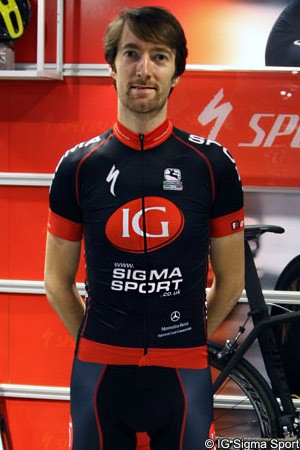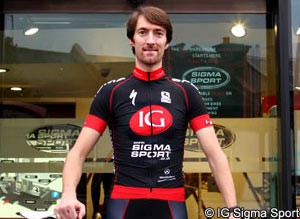Former WorldTour competitor shares knowledge in new series
 There is something quite special about watching a professional rider on the top of his form. It doesn’t matter what the discipline is – sprinting, climbing, time trialling, cyclo cross or mountain bike – when champions are at the top of their game, there is a gracefulness about their riding; they look at one with their bike, they look efficient.
There is something quite special about watching a professional rider on the top of his form. It doesn’t matter what the discipline is – sprinting, climbing, time trialling, cyclo cross or mountain bike – when champions are at the top of their game, there is a gracefulness about their riding; they look at one with their bike, they look efficient.
But what exactly is efficiency? Well, in purely mechanical terms, it is the ratio of work output to work input. As cyclists, we are very inefficient, in that only around 25% of the energy we produce goes into propelling the bike forward. The rest is lost through heat and other factors.
In this article, I am going to veer away from talking about efficiency in a mechanical or scientific context, and focus more on pedaling technique as a whole – what can we change, and will it lead to improvements in performance?
 The first, and possibly most obvious, point to discuss is cadence. During the Armstrong years, not only the public but also a lot of the pro peleton, suddenly decided that using a higher cadence would lead to improved performance. The premise of Armstrong’s coaches was that it led to improvements in the cardiovascular system and gave him less muscular fatigue during races or training blocks. What wasn’t really portrayed was the relationship between cadence and power. In the most part, the higher the power, the higher the corresponding cadence should be. So, whilst track sprinters are big, muscular athletes, their cadence during sprint events is very high due to the enormous amount of power they are producing.
The first, and possibly most obvious, point to discuss is cadence. During the Armstrong years, not only the public but also a lot of the pro peleton, suddenly decided that using a higher cadence would lead to improved performance. The premise of Armstrong’s coaches was that it led to improvements in the cardiovascular system and gave him less muscular fatigue during races or training blocks. What wasn’t really portrayed was the relationship between cadence and power. In the most part, the higher the power, the higher the corresponding cadence should be. So, whilst track sprinters are big, muscular athletes, their cadence during sprint events is very high due to the enormous amount of power they are producing.
Relating this to the general public, whilst it might seem a good idea to copy Tour de France winners’ cadence and technique, you must take into account that whilst they are riding up mountains at 400-500 watts, a keen amateur will generally only be doing 250-300w, thus the corresponding cadence should also be lower if you are looking for best performance.
Recent studies have also shown that self selected cadence is often best, so during races there is no need to artificially increase or decrease your cadence just because you think it should be better. On the other hand, there can be benefits of including various cadence drills into your training, and I often prescribe these sessions to riders that I coach at selected points leading up to their goals.
Another aspect of cycling technique often talked about is pedal stroke. I often hear riders striving to achieve a rounder pedal stroke, pedaling through the ‘deadspot’. If you are talking about riding off road, this technique is a must as surges of power on the downstroke will often lead to the rear wheel slipping over routes and mud, but this isn’t something which needs to be taken into account on the road.
Whilst riders such as Wiggins, Millar or Cancellara may appear to have a perfect pedal stroke, in reality they are producing the majority of their power when the pedals are between 2 o’clock and 5 o’clock. In fact, studies have shown that the discrepancy between power produced on the downstroke compared with the dead spot is greater in pro’s than the general public. If you think about it, it makes sense – why spend time developing smaller muscles to keep power through the deadspot, when you can use much larger muscles for the rest of the pedal stroke?
Recently, more and more riders, including myself, have started to use elliptical chainrings, such as those made by Rotor or O-Symmetric, in order to try and reduce the time spent in the dead spot. The jury is still out amongst both riders and scientists, but I always felt good with them. They certainly don’t seem to have done Wiggins any harm, as he has been using them since before his fourth place at the 2009 Tour. – Dan
About Dan Lloyd:
 A past stage winner in the Tour of Siam and Tour of Qinghai Lake, Dan Lloyd stepped up a level at the end of 2008, thanks in part to results such as victory in the Vuelta a Extremadura. He signed a contract with the Cervélo Test Team and competed with the team for two years. In that time, he placed fourth overall in the Tour of Qatar, and rode both the 2009 and 2010 Giro d’Italia plus the 2010 Tour de France.
A past stage winner in the Tour of Siam and Tour of Qinghai Lake, Dan Lloyd stepped up a level at the end of 2008, thanks in part to results such as victory in the Vuelta a Extremadura. He signed a contract with the Cervélo Test Team and competed with the team for two years. In that time, he placed fourth overall in the Tour of Qatar, and rode both the 2009 and 2010 Giro d’Italia plus the 2010 Tour de France.
During that time he supported the team’s top riders such as Thor Hushovd and Carlos Sastre.
When the Test Team folded, he transferred across to Garmin-Cervélo and raced there last season. His year was complicated by illness but he ended up solidly with tenth in the Tour of Britain. He’s now racing with the IG-Sigma Sport team but, at just 31 years of age, a return to the WorldTour is not out of the question.
Dan has recently announced that he will be working with Forme Coaching from 2012 onwards, while also continuing to compete. He’ll be contributing coaching articles to VeloNation on a range of topics.
Ask The Pro section:
Got questions for Dan Lloyd or ex-pros Dan Fleeman and Stephen Gallagher? Forme Coaching will answer reader’s questions in a new section of this website. Email your queries about racing and training to coaching@velonation.com and we’ll pass them on. Please provide your full name and contact details.